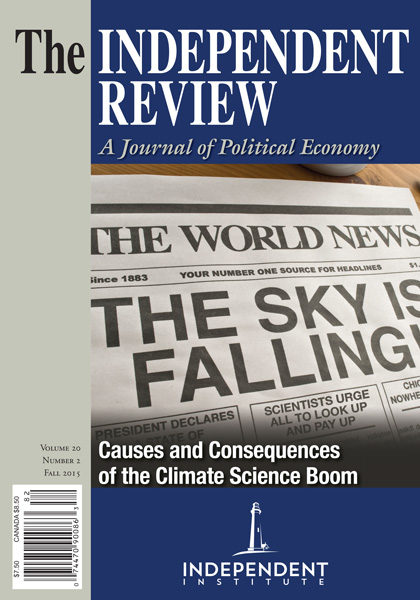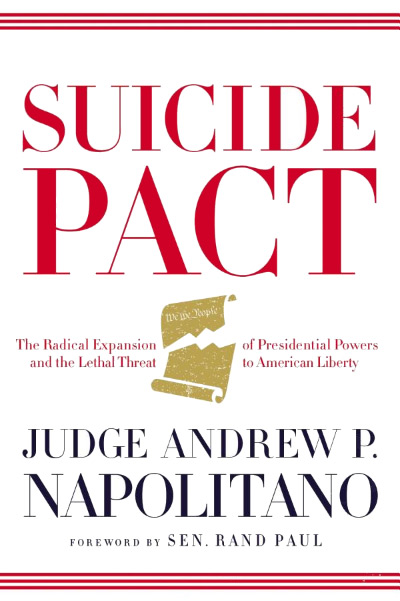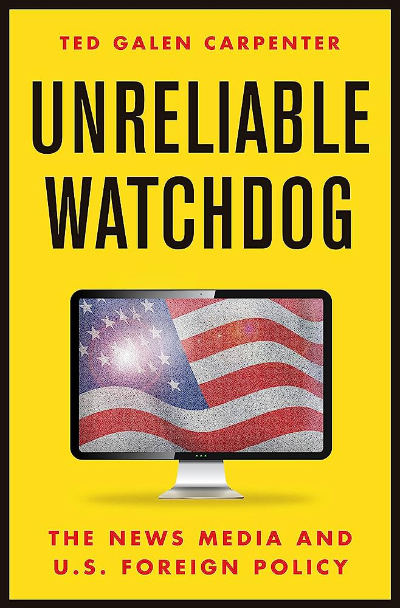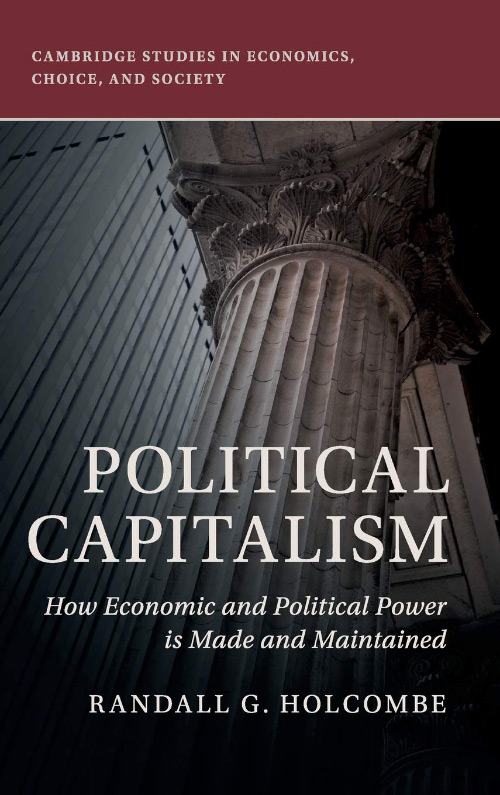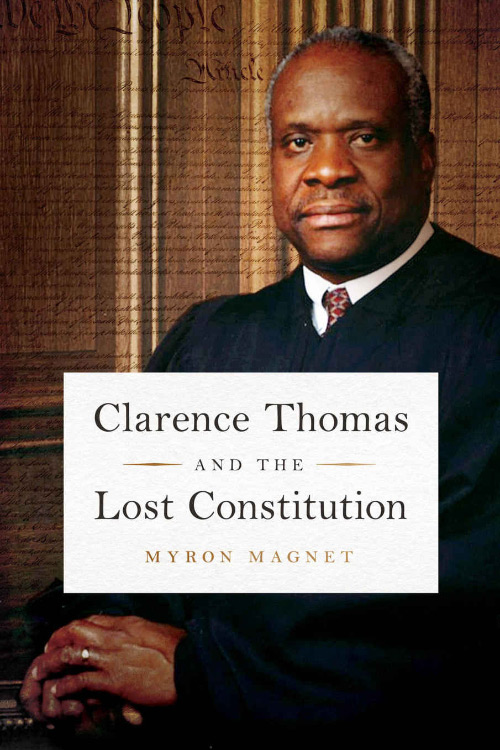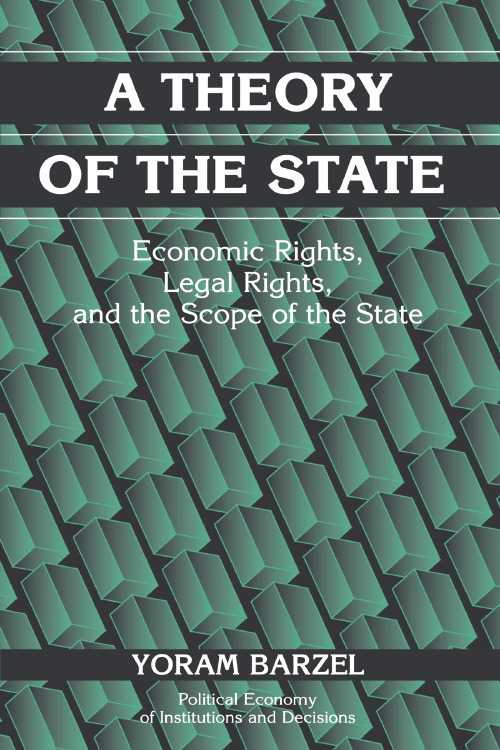Andrew P. Napolitano has written a thorough and well-written history of presidential trampling of constitutionally guaranteed civil liberties throughout U.S. history, especially during wars and times of international tension. Napolitano starts with the early republic, including John Adams’s suppression of free speech to mute his political opponents by using the Alien and Sedition Acts of 1798 during the Quasi-War with France. He then explores Abraham Lincoln’s virtual dictatorship during the Civil War, including Lincoln’s usurpation of power from Congress to suspend the writ of habeas corpus (leading to indefinite detention without trial and other legal due process) and his unconstitutional use of military commissions when civilian courts were still open and functioning.
Moving on to the World War I era, Napolitano analyzes Woodrow Wilson’s use of the Espionage Act of 1917 and the Sedition Act of 1918 to jail people for opposition to the war and his disregard of Americans’ economic rights by increasing dramatically government intrusion into the economy to convert it from peacetime to wartime production. Among other topics surrounding World War II, Napolitano explores the Smith Act of 1940, which was really a rehash of the Alien and Sedition Acts—once again criminalizing constitutionally protected political behavior and expediting the deportation of alien “thought criminals.” He also explores the readoption of the World War I model for a command economy during World War II. Napolitano then talks about Franklin D. Roosevelt’s reinstatement of Lincoln’s unconstitutional military commissions to try suspected German saboteurs and his incarceration of more than one hundred thousand Japanese Americans in prison camps despite no cases of bad wartime behavior on their part.
As for the long ColdWar, Napolitano finds plenty of executive encroachment on civil liberties. During the Korean War, Harry Truman, to sell his new policy of global interventionism to an American public that had been traditionally inclined to stay out of other nations’ business, started the Red Scare, which Joseph McCarthy and others exploited (pp. 144–65). Truman also unsuccessfully attempted to become commander in chief of the country rather than just of the armed forces by trying to nationalize American steel companies for war production; in the Youngstown Steel case, the Supreme Court rejected Truman’s ploy. The author then examines government spying and dirty tricks on civilian antiwar groups within the United States during the Vietnam War. He also gives the history of heavy-handed executive behavior by Richard Nixon, as demonstrated by Watergate and the scandal surrounding the Pentagon Papers.
Curiously, however, given the general theme of Napolitano’s book—that aggressive military action overseas leads to the suppression of civil liberties at home—he goes out of his way to blame Bill Clinton for not doing enough to combat al Qaeda. Although Bill Clinton did occasionally flail away with limited and ineffectual minor military strikes against the group (cruise missile strikes against an alleged chemical weapons factory in Sudan and al Qaeda camps in Afghanistan) and began an illegal rendition program, he pursued terrorists more as criminals—apprehending them and prosecuting them in civilian courts—than did his successors, as even Napolitano seems to recognize. Napolitano, a lawyer and judge, gives Clinton no credit for this approach, however, but instead implies the criticism that he did not do more militarily or covertly to battle al Qaeda. Napolitano attributes Clinton’s inaction to a loss of interest in pursuing al Qaeda (pp. 203–8). Yet this regarding of terrorism as a “war” (rather than as a crime), which was pursued by Clinton’s successors, George W. Bush and Barack Obama, is the main reason for the five chapters that Napolitano needs to catalog all of the civil liberties violations committed by the latter two presidents.
In fact, Clinton should be commended for avoiding taking the bait and giving anti-American terror groups exactly what they want—an over-the-top military response to their attacks—so that they could use it as an excuse to launch blowback retaliatory terrorist acts and generate more recruits and money for their cause. In fact, Lieutenant General Daniel P. Bolger notes that Osama bin Laden repeatedly and unsuccessfully tried to goad Clinton into such an over-the-top military response by perpetrating relatively small terrorist attacks on U.S. targets (WhyWe Lost: A General’s Inside Account of the Iraq and Afghanistan Wars [New York: Houghton Mifflin Harcourt, 2014], pp. 18–24). These targets included the U.S. embassies in Kenya and Tanzania in 1998 and the U.S.S. Cole warship docked in Yemen in 2000. In exasperation at not being able to provoke the United States, bin Laden resorted to a much more spectacular attempt to inflame U.S. policymakers with the attacks on New York and Washington, D.C., on September 11, 2001 (9/11), when bin Laden found—as he declared to the world—a U.S. president, GeorgeW. Bush, who was easy to bait.
Napolitano should be given great credit for stating what other authors avoid: that the United States sometimes creates its own enemies, as it did when the mujahideen, who were U.S. allies against the Soviets in Afghanistan, became al Qaeda; that U.S. interventionism in the Middle East leads to blowback terrorism; and that terrorism will never be wiped out as long as radicals exist and America has imperial tendencies (pp. 201–3, 216). Yet he does not emphasize a more restrained U.S. foreign policy overseas as a way to avoid the trade-off of liberty for alleged security that his book does an outstanding job of documenting in detail. Unfortunately, his very correct conclusion that the U.S. Constitution elevates liberty even over defense—national defense is supposed to protect the liberties that the American governmental system provides—is usually lost when the real world encroaches; lessening that encroachment is what a less assertive U.S. foreign policy would achieve.
In three full chapters, Napolitano mounts a legitimately scathing attack on George W. Bush’s flagrant aggrandizement of power, usurpation of American civil liberties, and resurrection of prior unconstitutional practices during crises: military commissions and the executive suspension of habeas corpus. Bush also authorized illegal and unconstitutional torture, which clearly violated long-standing international and domestic law. Finally, Napolitano lays out a comprehensive case on the extraconstitutional spying on Americans, which he says began much before the 9/11 attacks. All of these egregious violations of liberty were done to further centralize power in the executive branch by using the attacks to create a permanent state of emergency so that the president, as commander in chief, could ride roughshod over the legislative and judicial branches to do whatever he wanted in the name of national security.
Napolitano then correctly points out that Obama, a constitutional law professor, has done little to improve on most practices begun during the Bush administration and has an even worse record on some civil liberties issues. Seemingly, the two areas that saw the most improvement were the use of torture and the military commissions. The worst of the torture has apparently been stopped, but some less-drastic techniques in the army’s field manual are still permitted. Some additional defendant rights have been given to suspected terrorists tried before military commissions, but the panels are still unconstitutional kangaroo proceedings that do not meet the standards of civilian courts. Under the Obama administration, the executive’s unconstitutional suspension of habeas corpus continues, as does the equally unconstitutional warrantless domestic spying. Napolitano alleges that Obama’s record is worse on such privacy issues (p. 342), but he does not substantiate that claim very well.
In one area, Napolitano alleges that Obama has gone beyond Bush by unconstitutionally authorizing the killing of Americans by drones without any legal due process. He calls this murder (pp. 322–30). Napolitano is quite correct that it is murder, but the issue needs reframing.
First, Napolitano wrote this book before the revelation that Bush personally ordered the CIA to assassinate Imad Mughniyah, a well-known Hezbollah leader, with a car bomb in 2008. Mughniyah was not an American citizen, but, as Napolitano points out, Obama has killed at least four Americans with drone strikes, including Anwar al Awlaki of al Qaeda. Napolitano, like the media, has focused too much on dazzling lethal automated drone technology and the killing of Americans. Killing the citizens of other nations is murder, too, unless such military strikes have been constitutionally approved by Congress. Neither Bush’s nor Obama’s killing of people overseas in Yemen, Somalia, and Pakistan (Pakistani Taliban fighters) nor Bush’s killing of Mughniyah in Syria was part of a congressionally approved military action.
In major wars, Bush was better about getting congressional approval (in the Afghanistan and Iraq Wars) than Obama has been (the conflict in Libya). The post- 9/11 Authorization of the Use of Military Force (AUMF) by Congress approved armed action anywhere against the perpetrators or enablers of the 9/11 attacks or those that harbored them—that is, the central al Qaeda group and the Afghan Taliban. Yet Bush illegally stretched this congressional action to include al Qaeda and Talibanaffiliate groups in Yemen, Somalia, and Pakistan that had no role in the 9/11 attacks. Obama, upon taking office, accelerated drone attacks on all such affiliates.
The nation’s founders made very clear in the Constitution and in the debates at the Constitutional Convention that created it that all military actions, even minor ones, should be approved beforehand by the people’s branch of government. Only one justifiable exception exists: if the country is in imminent danger of attack, the president can take action in self-defense but even then should get congressional approval at the earliest possible time. Because the wars involving assassination of suspected terrorists with the use of drones and apparently car bombs outside the AUMF’s purview have been going on for significantly longer than a decade, with neither Bush nor Obama seeking congressional approval, the legitimate “self-defense from imminent attack” clearly does not apply constitutionally in any of these illegal conflicts.
Although Napolitano does note the executive’s usurpation of the congressional war power in his book, he does not give this important erosion of the constitutional checks and balances due attention. And although he does a good job of cataloging the deterioration of Americans’ economic liberties by government intrusion into the private sector during wartime, he does not mention at all the corrosion of Congress’s budgetary power and its aggrandizement by the executive, which started shortly after World War I. The disintegration of Congress’s war and budgetary powers throughout U.S. history has upended the Founders’ checks-and-balances system, which was originally designed to make the people’s branch, the Congress, the dominant arm of government to prevent executive abuse, which the kings of Europe doled out to their citizens. The current imperial presidency does affect citizens’ liberty, and Napolitano should have done a better job of covering this issue.
Napolitano’s solution to the government’s trampling of civil liberties is “to have people in government who do believe in the Natural Law, and to have systems in place to change and diminish the government, not grow it” (p. 346). Yet this vague solution runs afoul of Lord Acton’s axiom: “Power corrupts, and absolute power corrupts absolutely.” Look at Barack Obama, a constitutional law professor who pledged a restoration of lost civil liberties but who has given us more of the same. The real solution is greater public education about and awareness of the constitutional framers’ intent in order to keep the politicians honest and to combat the fear that they regularly peddle.
Overall, however, Napolitano’s book is an excellent overview of the history of American liberty and, with a few exceptions, demonstrates the prescience of Thomas Jefferson’s prediction that liberty usually gives way in the face of government power.
| Other Independent Review articles by Ivan Eland | ||
| Fall 2022 | The Right: The Hundred-Year War for American Conservatism | |
| Summer 2022 | America’s Rise and Fall among Nations: Lessons in Statecraft from John Quincy Adams | |
| Fall 2016 | “Independent Internationalism” and the Military Forces Needed for It | |
| [View All (6)] | ||

